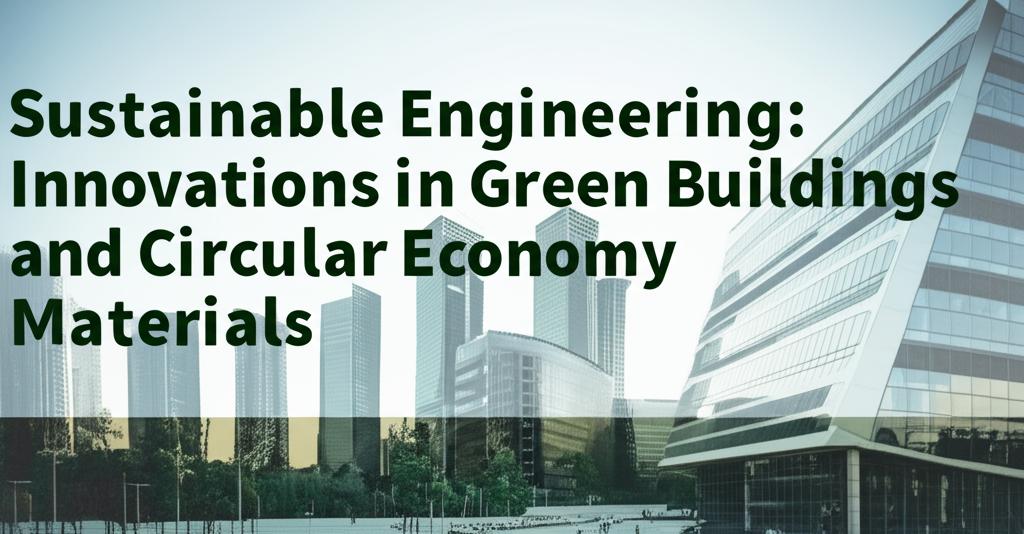The construction industry is experiencing a significant transformation towards sustainability, driven by environmental concerns and technological advancements. This shift involves a holistic approach, re-evaluating how buildings are designed, constructed, function, and interact with their environment. Key aspects include integrating renewable energy, leveraging smart technology, adopting climate-resilient strategies, and embracing circular economy principles.
Innovations in Green Building Design and Materials:- Sustainable Materials: There's a growing demand for materials that reduce carbon footprints, improve energy efficiency, and enhance building longevity.
Cross-Laminated Timber (CLT): An engineered wood product gaining popularity as a strong, lightweight, and sustainable alternative to conventional materials like concrete and steel. It offers a lower carbon footprint and can reduce construction time.
Low-Carbon and Carbon-Negative Concrete: Innovations aim to reduce concrete's significant carbon dioxide emissions. This includes using alternative fuels for production (like biomass or solar), replacing cement with recycled materials (such as slag, fly ash, or natural pozzolans), and even developing bio-concrete that uses microalgae to produce calcium carbonate. Recycled concrete and aggregate from demolished structures are also gaining traction.
Bio-Based Materials: Derived from renewable resources like bamboo, cork, mycelium (the root structure of fungi), and agricultural waste, these materials can act as carbon sinks. Bio-based plastics and insulation are emerging as alternatives to fossil fuel-based products.
Recycled Materials: The use of recycled steel, plastic lumber, reclaimed wood (from old structures or shipping pallets), and foamed glass aggregate (made from 100% recycled glass) is increasing, promoting a circular economy and reducing reliance on virgin resources.
Advanced Insulation: Materials like aerogel (a silica-derived, highly effective insulator), vacuum insulated panels (ultra-thin with high insulating properties), and phase change materials (PCMs that absorb and release heat to regulate temperature) are improving building energy efficiency. FenX converts mineral waste into recyclable insulation foams.
Smart Materials: Innovations include smart glass that adjusts transparency based on sunlight, and even smart bricks capable of generating electricity.
Other Notable Materials: Terra-cotta tiles (recyclable, durable, and fire-resistant), low and zero-VOC (volatile organic compound) paints (improving indoor air quality), and fabric structures are also contributing to greener buildings. Algae-powered bioreactor walls can produce oxygen and absorb carbon dioxide.
- Energy Efficiency and Renewable Energy Integration:
Net-Zero Energy Buildings (NZEBs): The goal is to design buildings that produce as much clean energy as they consume. This involves integrating renewable energy sources like solar panels (including solar windows and roofing tiles integrating solar cells) and wind turbines.
Energy-Efficient Systems: Innovations in HVAC (heating, ventilation, and air conditioning) systems, smart lighting, smart thermostats, and advanced insulation are crucial. Smart building technology uses sensors and AI to optimize energy consumption in real-time based on occupancy and weather.
Passive Design Strategies: Optimizing building orientation for natural light and ventilation, using high-performance windows (like fiberglass or low-emissivity glass), and incorporating green roofs and walls are key. Green roofs and walls also enhance biodiversity, improve air quality, and manage stormwater.
* Energy Storage: Advanced battery storage allows buildings to store excess renewable energy, increasing energy independence.
- Water Conservation: Strategies include low-flow fixtures, rainwater harvesting systems, greywater recycling, and drought-resistant landscaping with efficient irrigation.
- Prioritizing Occupant Health: Focus is increasing on indoor air quality through better ventilation and the use of low-VOC materials. Biophilic design, which incorporates natural elements into buildings, is recognized for improving well-being and cognitive function.
The traditional linear model of "take-make-consume-waste" is being challenged by circular economy principles, which emphasize reuse, recycling, and resource efficiency.
- Designing for Disassembly and Reuse: Buildings are increasingly designed with longevity and future adaptation in mind. This involves creating structures and using modular components that can be easily disassembled, repaired, refurbished, remanufactured, or repurposed at the end of their initial life cycle. This approach significantly reduces waste and the need for virgin materials.
- Material Passports: These digital documents track the materials used in a building, providing information on their composition, origin, and potential for reuse or recycling. This facilitates "urban mining," where existing buildings are viewed as sources of valuable materials.
- Waste Reduction and Management: A key focus is on minimizing construction and demolition waste (C&DW). This includes on-site recycling systems, reusing materials like crushed concrete, and diverting debris from landfills. The European Commission, for instance, has set targets for recycling C&DW as part of its Circular Economy Action Plan.
- Modular and Prefabricated Construction: Building components manufactured off-site in a factory and then assembled on-site can reduce waste, shorten project timelines, improve quality control, and integrate sustainable materials more efficiently.
- Digital Tools: Building Information Modeling (BIM) and other digital technologies are crucial for planning, managing materials effectively, tracking resources, and optimizing for circularity throughout a building's lifecycle. AI-driven systems can also monitor energy consumption and resource usage in real-time.
- Market Growth: The global sustainable construction materials market is experiencing significant growth, projected to continue its upward trend. This is fueled by increasing adoption of energy-efficient materials, demand for net-zero buildings, and advancements in renewable energy integration.
- Regulatory Landscape: Governments worldwide are implementing stricter energy performance standards and regulations, such as the EU's Green Deal and the Future Homes Standard in the UK. These policies are pushing the industry towards decarbonization and sustainable practices. Financial incentives like tax reductions or subsidies for using recycled materials also play a role.
- Technological Advancement: Ongoing innovation in materials science, digital tools (like BIM and AI), automation, and prefabrication continues to drive sustainability in construction.
- Corporate and Investor Interest: There's growing interest from corporations and investors in sustainable development, recognizing the long-term cost savings, resilience, and environmental responsibility associated with green buildings and circular economy practices.
The construction industry is on a transformative journey towards a more sustainable and circular future. By embracing new materials, innovative designs, smart technologies, and circular economy principles, the sector can significantly reduce its environmental impact, create healthier and more efficient buildings, and contribute to global climate goals.

